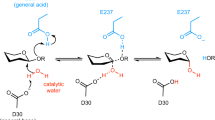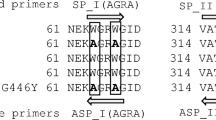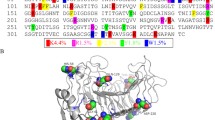Abstract
This is the first report of inactivation of xyloglucanase from Thermomonospora sp by pepstatin A, a specific inhibitor towards aspartic proteases. The steady state kinetics revealed a reversible, competitive, two-step inhibition mechanism with IC 50 and K i values of 3.5 ± 0.5 μM and 1.25 ± 0.5 μM respectively. The rate constants determined for the isomerization of EI to EI* and the dissociation of EI* were 14.5 ± 1.5 × 10−5 s−1 and 2.85 ± 1.2 × 10−8 s−1 respectively, whereas the overall inhibition constant K i * was 27 ± 1 nM. The conformational changes induced upon inhibitor binding to xyloglucanase were monitored by fluorescence analysis and the rate constants derived were in agreement with the kinetic data. The abolished isoindole fluorescence of o-phthalaldehyde (OPTA)-labeled xyloglucanase and far UV analysis suggested that pepstatin binds to the active site of the enzyme. Our results revealed that the inactivation of xyloglucanase is due to the interference in the electronic microenvironment and disruption of the hydrogen-bonding network between the essential histidine and other residues involved in catalysis.







Similar content being viewed by others

References
Gloster TM, Ibatullin FM, Macauley K, Eklo JM, Roberts S et al (2007) Characterization and three-dimensional structures of two distinct bacterial xyloglucanases from families GH5 and GH12*. J Biol Chem 282:19177–19189
Martinez-Fleites C, Guerreiro CIPD, Baumann MJ, Taylor EJ et al (2006) Crystal structures of Clostridium thermocellum xyloglucanases, XGH74A, reveal the structural basis for xyloglucan recognition and degradation. J Biol Chem 281:24922–24933
Benko Z, Siika-aho M, Viikari L, Reczey K (2008) Evaluation of role of xyloglucanase in the enzymatic hydrolysis of lignocellulosic substrates. Enzym Microb Technol 43:109–114
Menon V, Prakash G, Rao M (2010) Enzymatic hydrolysis and ethanol production using xyloglucanase and debaryomyces hansenii from tamarind kernel powder: galactoxyloglucan predominant hemicelluloses. J Biotechnol 148:233–239
Wong DDWS, Chan VJ, McCormack AA, Batt SB (2010) A novel xyloglucan- specific endo-β-1,4- glucanase: biochemical properties and inhibition studies. Appl Microbiol Biotechnol 86:1463–1471
Sørensen JF, Kragh KM, Sibbesen O, Delcour J, Goesaert H, Svensson et al (2004) Potential role of glycosidase inhibitors in industrial biotechnological applications. Biochim Biophys Acta 1696:275–287
York WS, Qin Q, Rose JK (2004) Proteinaceous inhibitors of endo-beta-glucanases. Biochim Biophys Acta 1696:223–233
Hanada K, Nishiuchi Y, Hirano H (2003) Amino acid residues on the surface of soybean 4-kDa peptide involved in the interaction with its binding protein. Eur J Biochem 270:2583–2592
Scarafoni A, Ronchi A, Duranti M (2010) gamma- Conglutin, the Lupinus albus XEGIP-like protein, whose expression is elicited by chitosan, lacks the typical inhibitory activity against GH12 endo-glucanases. Phytochemistry 71:142–148
Yoshizawa T, Shimizu T, Yamabe M, Taichi M, Nishiuchi Y, Shichijo N et al (2011) Crystal structure of basic 7S globulin, a xyloglucanspecific endo-β-1,4-glucanase inhibitor protein-like protein from soybean lacking inhibitory activity against endo-β-glucanase. FEBS J 278:1944–1954
Yoshizawa T, Shimizu T, Hirano H, Sato M, Hashimoto H (2012) Structural basis for the inhibition of xyloglucan-specific endo-β-1,4-glucanase (XEG) by XEG-protein inhibitor. J Biol Chem. doi:10.1074/jbc.M112.350520
Umezawa H, Aoyagi T, Morishima H, Hamed M, Takeuchi T (1970) Pepstatin, a new pepsin inhibitor produced by Actinomycetes. J Antibiot 23:259–262
Eder J, Hommel U, Cumin F, Martoglio B, Gerhartz B (2007) Aspartic proteases in drug discovery. Curr Pharm Des 13:271–285
Dash C, Kulkarni A, Dunn B, Rao M (2003) Aspartic protease inhibitors: implications in drug development. Crit Rev Biochem Mol 38:89–119
Nguyen J-T, Hamada Y, Kimura T, Kiso Y (2008) Design of potent aspartic protease inhibitors to treat various diseases. Arch Pharm Chem Life Sci 341:523–535
Vinod V, Rao M (2004) Slow tight binding inhibition of xylanase by an aspartic protease inhibitor. J Biol Chem 279:47024–47033
Pol D, Menon V, Rao M (2012) Biochemical characterization of a novel thermostable xyloglucanase from an alkalothermophilic Thermomonospora sp. Extremophiles 16:135–146
Mandels M, Weber J (1969) The production of cellulases. Adv Chem 95:391–414
Lowry F, Rosebrough NJ, Farr AL, Randall RJ (1951) Protein measurement with the folin phenol reagent. J Biol Chem 193:265–275
Dixon M (1953) Determination of enzyme-inhibitor constants. Biochem J 55:170–171
Cleland WW (1979) The kinetics of enzyme catalyzed reactions with two or more substrates or products—II: inhibition, nomenclature and theory. Biochim Biophys Acta 67:173–187
Morrison JF, Walsh CT (1988) The behaviour and significance of slow-binding inhibitors. Adv Enzymol Relat Areas Mol Biol 61:201–302
Lakowicz JR (1983) Principles of fluorescence spectroscopy. Plenum, NY
Rich DH, Bernatowicz MS, Agarwal NS, Kawai M, Salituro FG, Schmidt PG (1985) Inhibition of aspartic proteases by pepstatin and 3-methylstatine derivatives of pepstatin. Evidence for collected-substrate enzyme inhibition. Biochemistry 24:3165–3173
Legler G (1990) Glycoside hydrolases: mechanistic information from studies with reversible and irreversible inhibitors. Adv Carbohydr Chem Biochem 48:319–385
Withers SG, Aebersold R (1995) Approaches to labeling and identification of active site residues in glycosidases. Protein Sci 4:361–372
Rossi LL, Basu A (2005) Glycosidase inhibition by 1-glycosyl-4-phenyl triazoles. Bioorg Med Chem Lett 15:3596–3599
Yuasa H, Izumi M, Hashimoto H (2009) Thiasugars: potential glycosidase inhibitors. Curr Top Med Chem 9:76–86
Stutz AE (1999) Immunosugars as glycosidase inhibitors: nojirimycin and beyond. Wiley, Weinheim, pp 95–120
Pawagi AB, Deber CM (1990) Ligand-dependent quenching of tryptophan fluorescence in human erythrocyte hexose transport protein. Biochemistry 20:950–955
Cheung HC (1991) Topics in fluorescence spectroscopy. In: Lakowicz JR (ed) Principles, vol 2. Plenum, New York, pp 127–176
Simons SS Jr, Johnson DF (1978) Reaction of o-phthalaldehyde and thiols with primary amines: fluorescence properties of 1-alkyl (and aryl) thio-2-alkylisoindoles. Anal Biochem 90:705–725
Palczewski K, Hargrave PA, Kochman M (1983) o-phthalaldehyde, a fluorescence probe of aldolase active site. Eur J Biochem 137:429–435
Marciniszyn J, Hartsuck JA, Tang J (1976) Mode of inhibition of acid proteases by pepstatin. J Biol Chem 251:7088–7709
Acknowledgments
MR and VM acknowledge the financial support and the senior research fellowship from CSIR Emeritus Scheme, Govt. of India respectively. MR is thankful to Dr Barry McCleary, Megazyme International Ireland Ltd for xyloglucan from tamarind seeds.
Author information
Authors and Affiliations
Corresponding author
Rights and permissions
About this article
Cite this article
Menon, V., Rao, M. Mechanistic Insights into the Inhibition of Endo-β 1,4 Xyloglucan Hydrolase by a Classical Aspartic Protease Inhibitor. J Fluoresc 23, 311–321 (2013). https://doi.org/10.1007/s10895-012-1149-7
Received:
Accepted:
Published:
Issue Date:
DOI: https://doi.org/10.1007/s10895-012-1149-7



